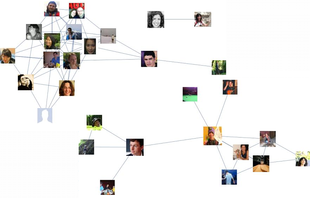|
|
| Line 38: |
Line 38: |
|
|
|
|
|
<math>(\leftarrow)</math> Assume <math>I=V-C</math> is independent. Pick any edge <math>e = (ab)\in{E}</math>. As <math>I</math> is independent, |
|
<math>(\leftarrow)</math> Assume <math>I=V-C</math> is independent. Pick any edge <math>e = (ab)\in{E}</math>. As <math>I</math> is independent, |
|
<math>(ab)</math> does not connect <math>a,b</math>. Hence, either <math>a\notin{I} \implies a\in{C}</math> or <math>b\notin{I} \implies b\in{C}</math>, which implies <math>e</math> is incident to an element of <math>C</math>. QED |
|
<math>(ab)</math> does not connect any two members of <math>I</math>. Hence, either <math>a\notin{I} \implies a\in{C}</math> or <math>b\notin{I} \implies b\in{C}</math>, which implies <math>e</math> is incident to an element of <math>C</math>. QED |
Revision as of 22:44, 15 September 2015
| Welcome to Math 344!
|
| Edits to the Math 344 web sites no longer count for the purpose of good deed points.
|
| #
|
Week of...
|
Notes and Links
|
| 1
|
Sep 14
|
About This Class, Day One Handout, Tuesday, Hour 3 Handout, Thursday, Tutorial 1 Handout
|
| 2
|
Sep 21
|
Tuesday, Tutorial 2 Page 1, Tutorial 2 Page 2, Thursday, HW1
|
| 3
|
Sep 28
|
Tuesday, Class Photo, Tutorial 3 Page 1, Tutorial 3 Page 2, Thursday, HW2
|
| 4
|
Oct 5
|
Tuesday, Drawing  -cubes, Thursday, HW3 -cubes, Thursday, HW3
|
| 5
|
Oct 12
|
Tuesday, Tutorial Handout, Thursday, HW4
|
| 6
|
Oct 19
|
Tuesday, Tutorial Handout, Thursday
|
| 7
|
Oct 26
|
Term Test on Tuesday, Dijkstra Handout,Thursday,HW5
|
| 8
|
Nov 2
|
Tuesday, Tutorial Handout, Thursday, HW6, Sunday November 8 is the last day to drop this class
|
| 9
|
Nov 9
|
Monday-Tuesday is UofT Fall Break, Thursday, HW7
|
| 10
|
Nov 16
|
Tuesday, Thursday, HW8
|
| 11
|
Nov 23
|
Tuesday, Thursday, HW9
|
| 12
|
Nov 30
|
Tuesday, Thursday, HW10
|
| 13
|
Dec 7
|
Tuesday, FibonacciFormula.pdf, semester ends on Wednesday - no class Thursday
|
| F
|
Dec 11-22
|
The Final Exam
|
| Register of Good Deeds
|

Add your name / see who's in!
|

|
|
We mostly went over Day One Handout today.
|
|
Dror's notes above / Students' notes below
|
|
Lecture Note for September 15
DEFINITION 1 Graph A graph  is a set
is a set  (usually finite, "vertices")
along with a set
(usually finite, "vertices")
along with a set  ("edges") of unordered pairs of distinct elements of
("edges") of unordered pairs of distinct elements of
 .
.
DEFINITION 2 Incident If an edge  , we say that
, we say that  is incident to
is incident to  and
and  .
.
DEFINITION 3 N-valent In a graph  , a vertex
, a vertex  is called
bivalent if it is incident to precisely two edges and n-valent if incident to precisely n edges, where
is called
bivalent if it is incident to precisely two edges and n-valent if incident to precisely n edges, where  .
.
DEFINITION 4 Edge Cover An edge cover for graph  is a subset
is a subset  such that every edge of
such that every edge of  incident to at least one vertex in
incident to at least one vertex in  .
.
DEFINITION 5 Independent Let  be a graph. A subset
be a graph. A subset  is called independent if whenever
is called independent if whenever  , then
, then  .
.
THEOREM 1 Edge covers are complementary to independent sets. In other words,  is an edge cover if and only if
the complementary subset
is an edge cover if and only if
the complementary subset  is an independent set.
is an independent set.
Proof
 Assume
Assume  is an edge cover. I assert that
is an edge cover. I assert that  is independent.
Indeed, if
is independent.
Indeed, if  , then since
, then since  is an edge cover, either
is an edge cover, either  or
or
 , which implies
, which implies  are not connected.
are not connected.
 Assume
Assume  is independent. Pick any edge
is independent. Pick any edge  . As
. As  is independent,
is independent,
 does not connect any two members of
does not connect any two members of  . Hence, either
. Hence, either  or
or  , which implies
, which implies  is incident to an element of
is incident to an element of  . QED
. QED





























